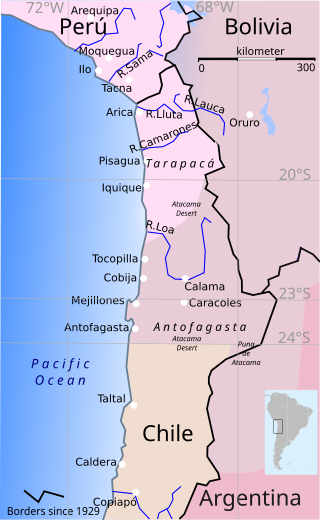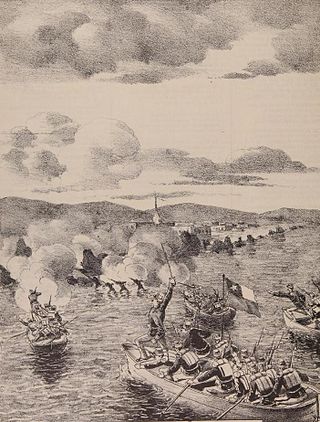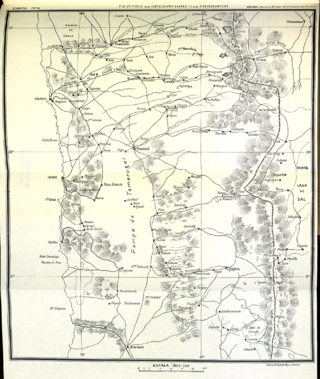
The War of the Pacific, also known by multiple other names, was a war between Chile and a Bolivian–Peruvian alliance from 1879 to 1884. Fought over Chilean claims on coastal Bolivian territory in the Atacama Desert, the war ended with victory for Chile, which gained a significant amount of resource-rich territory from Peru and Bolivia.

The Battle of Angamos was a naval encounter of the War of the Pacific fought between the navies of Chile and Perú at Punta Angamos, on 8 October 1879. The battle was the culminating point of a naval campaign that lasted about five months in which the Chilean Navy had the sole mission of eliminating its Peruvian counterpart. In the struggle, two armored frigates, led by Commodore Galvarino Riveros Cárdenas and Navy Captain Juan José Latorre battered and later captured the Peruvian monitor Huáscar, under Rear Admiral Miguel Grau Seminario.

The Battle of Pisagua, was a landing operation of the War of the Pacific, fought on November 2, 1879, between Chile and the combined forces of Bolivia and Peru. The Chilean army commanded by Erasmo Escala, supported by the Chilean Fleet, launched an amphibious assault on the port of Pisagua and successfully drove the defending Bolivian-Peruvian forces, led by Gen. Juan Buendia, back from the shore. They established a beachhead that allowed an initial force of about 1,000 Chilean soldiers in two assault waves to disembark onto Peruvian territory at Pisagua in Tarapacá Department. This region was the principal territory in dispute.

The Battle of Punta Gruesa was a naval action that took place on May 21, 1879, during the War of the Pacific between Chile and Peru. This may be labelled as the second part of the Naval Battle of Iquique, although it is described in many sources as a separate battle.

The Battle of Tacna, also known as the Battle of the Peak of the Alliance, effectively destroyed the Peru-Bolivian alliance against Chile, forged by a secret treaty signed in 1873. On 26 May 1880, the Chilean Northern Operations Army led by General Manuel Baquedano González, conclusively defeated the combined armies of Peru and Bolivia commanded by Bolivian President, General Narciso Campero. The battle took place at the Inti Urqu (Intiorko) hill plateau, a few miles north of the Peruvian city of Tacna. As a result, Bolivia was knocked out of the war, leaving Peru to fight the rest of the war alone. Also, this victory consolidated the Chilean domain over the Tarapacá Department. The territory was definitively annexed to Chile after the signing of the Tratado de Ancón, in 1884, which ended the war. Tacna itself remained under Chilean control until 1929.

The Tarapacá campaign was a short stage of the War of the Pacific in the last months of 1879, after the Chileans won definitive naval superiority at Angamos. It took its name from the region where it was fought.
The Battle of Callao was a confrontation during the War of the Confederation, between the Chilean blockade of Callao under the command of Commander Bynnon and the Confederate privateer fleet under Jean Blanchet.

The Lima campaign is the third land campaign of the War of the Pacific, carried out by Chile between December 1880 and January 1881. The campaign ended with the Chilean occupation of the Peruvian capital and the establishment of the Chilean authority in it and other surrounding territories, which would extend until 1883, with the end of the war.
Colo Colo was a Colo Colo-class torpedo boat built for the Chilean Navy in 1880. The torpedo boat participated in the War of the Pacific, where it fought in the blockade of Callao and patrolled Lake Titicaca in the final phase of that war.

The Naval Battle of Arica was a naval battle which took place on 27 February 1880 during the Blockade of Arica as part of the War of the Pacific.

The Guacolda was a torpedo boat bought by Peru at the beginning of the War of the Pacific, but captured by the Chilean Navy in the Ecuadorian port of Ballenita before being commissioned.

The Pilcomayo was a gunboat of the Peruvian Navy which was involved in several actions during the War of the Pacific. Captured by the Chilean Navy on November 18, 1879, she was repaired and participated in the blockade of the Peruvian ports. After the war it was used for hydrographic research, then as a training ship. In service until 1909, Pilcomayo was finally used as a pontoon at Talcahuano.

The Battle of Quillagua was a battle of the War of the Pacific that occurred on October 10, 1879. It was the first ever land battle between the Peruvian and Chilean infantry.

The Raids of the Huáscar were a series of raids that occurred by the Peruvian ironclad Huáscar under the command of Miguel Grau Seminario during the War of the Pacific. The actions kept the Chilean government in check for nearly five months which ended after the Battle of Angamos.
The Second Battle of Iquique was a naval battle of the War of the Pacific that occurred on July 10, 1879. During the battle, the Huáscar faced the 2nd Chilean Naval Squadron which was blockading the port which lead to both forces to face each other.

The Capture of the steamer Rímac or the Hunt and seizure of the Chilean transport Rímac was a part of the Raids of Huáscar during the Naval campaign of the War of the Pacific. During an expedition over the conflicting seas, the Peruvian Navy ships, Huáscar and Unión, apprehend the Chilean war steamer Rímac, which was an artillery transport, taking all its cargo and capturing its crew, including a squad of the Carabineros de Yungay. In Chile, the news of the capture of the Rímac detonated a political and social crisis that led to the resignation of several government officials, including Rear Admiral Juan Williams Rebolledo, Commander General of the Chilean Navy.

The Second Battle of Antofagasta took place during the Naval campaign of the War of the Pacific between the Peruvian ironclad Huáscar against the Chilean corvettes Abtao and Magallanes as well as the land defenses at Antofagasta.

The Capture of the corvette Pilcomayo was a battle of the Naval campaign of the War of the Pacific. In the battle, the Peruvian gunboat Pilcomayo was captured by the Chilean ironclad Blanco Encalada after a brief confrontation.

Carlos Ferreyros y Senra was a Peruvian Navy officer and politician. He was the commander of the gunboat Pilcomayo during the War of the Pacific, commanding it before its capture. He was also a Senator of the Department of Huánuco from July 28, 1907, to February 6, 1910, where he died in office.

The Rupture of the Blockade of Arica was a naval battle of the War of the Pacific during the Blockade of Arica. The rupture was carried out by Manuel Villavicencio who commanded the BAP Unión of the Peruvian Navy. The Unión broke the Chilean blockade of the port twice in less than 8 hours on March 17, 1880.

















